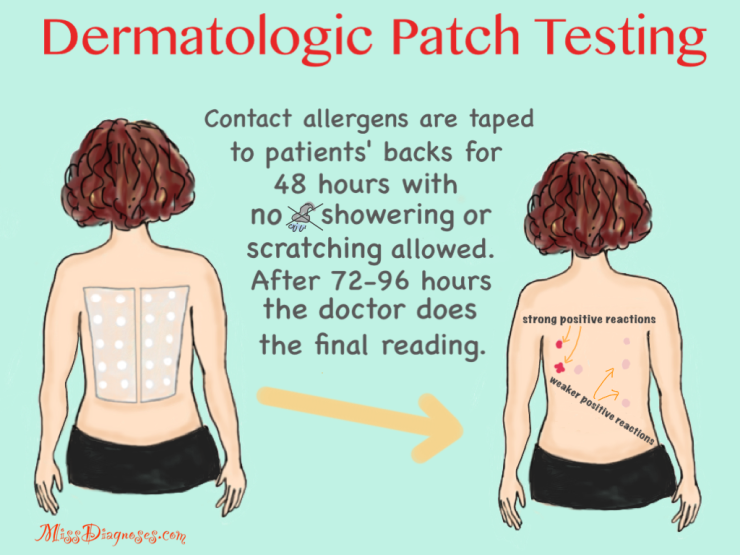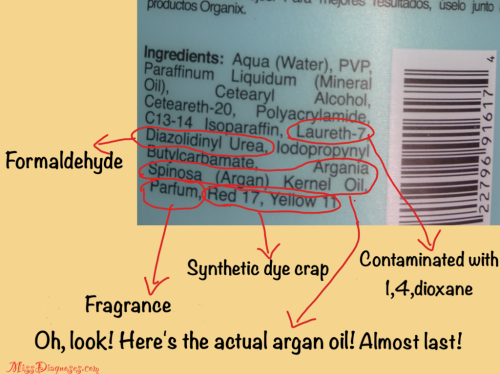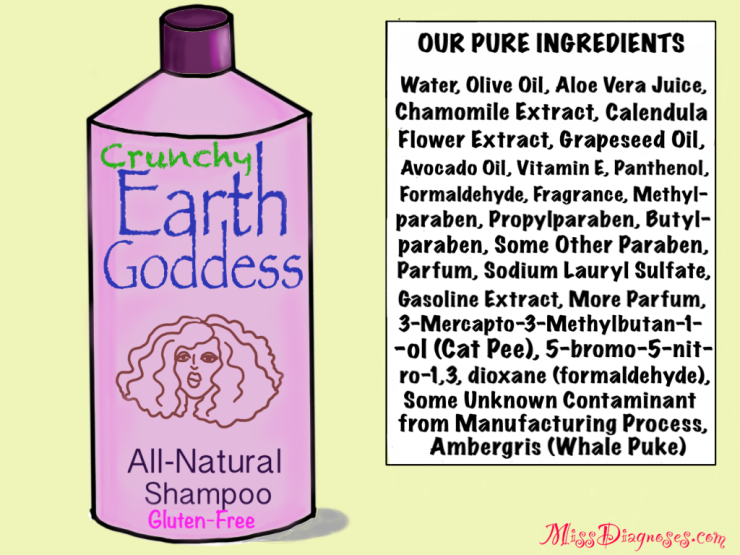Lots of people have heard about the dangers of parabens, but there are many other chemicals to hate in hair products.
I wasn’t a label reader until I was diagnosed with allergic contact dermatitis. My previously clear skin turned into a tomato-red, bumpy, rashy, burning mess. I had to go to a special dermatologist for patch testing.  It turned out I was allergic to a bunch of commonly used chemicals. One of them was a preservative that was in my supposedly “natural” conditioner and styling gel. By the way, “natural” is a marketing term and is not regulated. “Hypoallergenic” and dermatologist-tested are also marketing terms. The FDA does not regulate cosmetics in general; the cosmetic industry regulates itself. And unlike the EU, the U.S. does not have a long list of banned substances. They have over 1,000. We have about 11. After the patch testing, my doctor gave me a list of products that didn’t have my allergens.
It turned out I was allergic to a bunch of commonly used chemicals. One of them was a preservative that was in my supposedly “natural” conditioner and styling gel. By the way, “natural” is a marketing term and is not regulated. “Hypoallergenic” and dermatologist-tested are also marketing terms. The FDA does not regulate cosmetics in general; the cosmetic industry regulates itself. And unlike the EU, the U.S. does not have a long list of banned substances. They have over 1,000. We have about 11. After the patch testing, my doctor gave me a list of products that didn’t have my allergens.
Unfortunately, the list said there were no “ethnic” hair products. Sorry, you fuzzy-headed “ethnics”! No hair products for you! Go back to your ethnic place! My hair is wavy, curly, and intensely frizzy and it really needs all the moisture/frizz-reduction/any help at all it can get. So I had to do my own research. In addition to my allergens, I found a bunch of other obnoxious ingredients to avoid:
1) Formaldehyde Releasers: These preserve products by slowly releasing formaldehyde to prevent the growth of microorganisms (yes, formaldehyde is the same stuff used to preserve the frog you dissected in middle-school science class). Formaldehyde is a carcinogen as well as a skin and respiratory irritant, but the cosmetic industry insists that the small amount of formaldehyde released into individual products is not harmful. Still, these preservatives are used in many different products, so I wonder about the cumulative effects. Here are the most common names:
Quaternium-15
DMDM hydantoin
Diazolidinyl urea
Imidiazolidinyl urea
Germall, Germall Plus (contain diazolidinyl urea)
Bronopol
If you walk through the moisturizer and the hair product aisles of a drugstore, you’ll see a lot of formaldehyde releasers (mostly the first three names).
2) Fragrance: Because fragrance is licensed as a “trade secret,” manufacturers can use any combination of 3,000-plus fragrance chemicals without listing them individually on the label — the label will just say “fragrance,” “parfum,” or “aroma.” Fragrance ingredients can cause allergies and sensitivities, migraines and other types of headaches, respiratory distress, skin irritation, endocrine and hormone disruption, cognitive issues, and cancer. Products that say “unscented” can still have a masking fragrance. “Fragrance-free” is the best label to look for, although it isn’t legally regulated and sometimes just means “no added fragrance.” Certain essential oils, such as ylang-ylang oil, can also be allergens. Some companies, such as Unilever, are starting to disclose their fragrance ingredients, but they’re still not legally required to do so.
3) Sodium Lauryl Sulfate/Sodium Laureth Sulfate: Sodium lauryl sulfate is a surfactant, meaning it removes oil-based dirt. It’s very harsh, can cause skin and eye irritation, and will just dry the hell out of your hair (especially for people with curly or frizzy hair). Its cousin, sodium laureth sulfate, is often contaminated with a carcinogenic compound called 1,4 dioxane that is never, ever found on labels because it’s a byproduct of manufacturing. Here’s some more info on sulfates.
4) Propylene Glycol: This chemical is a skin irritant and a penetration enhancer, which means that it changes the skin’s structure to allow chemicals to get beneath the skin and into the bloodstream. If there are any toxic chemicals in the product you’re using, the presence of propylene glycol means they’re more likely to get into your system. Did I mention that propylene glycol is also the main ingredient in antifreeze? Yum! Finally, propylene glycol allergy is very common, so if you’re prone to allergies you might want to stay away. If you develop a PG allergy it’s almost impossible to avoid it, as it’s in medications and supplements as well as skin preparations.
5) Methyliosthiazolinone/Methylchloroisothiazolinone: These two are very common skin irritants and allergens with possible links to neurotoxicity. Full disclosure: They’re so common that I couldn’t find a fragrance-free dishwashing soap without them, so I use gloves to do dishes.
6) A Really Long-Ass List of Botanical Ingredients: I don’t actually avoid this – I just make sure to patch test. It’s a myth that you can’t react to natural ingredients. One of the fragrance chemicals I’m allergic to is also present in cinnamon oil. If you see a long list of botanicals and you’re an allergic type, my dermatologist recommends patch testing the product on the inside of your elbow for two weeks. So, what to do? I avoid most commercial brands because companies tend to take the one good ingredient in their product and use it for marketing while throwing in a lot of other garbage. Take this “argan oil” hair cream:  I tend to order from natural specialty companies or make my own products, which leads me to:
I tend to order from natural specialty companies or make my own products, which leads me to:
EASY DIY PRODUCT RECIPES FOR PEOPLE WITH NO ENERGY!
There are a gazillion beauty recipes online. I don’t have the spoons for things that involve a lot of melting and blending. If you’re allergic to nickel, you’ll want to be careful with nut and seed oils. I’m mildly allergic to nickel, and I’m usually OK with everything except shea butter, but test to be sure. A lot of online recipes involve essential oils, but they trigger my fragrance sensitivity, so I leave them out. The products turn out fine without them.
Aloe/Jojoba Styling Gel
3 parts aloe vera
1 part jojoba oil
Mix and bottle (it’s easier to pour with a funnel). That’s it! This is light and suitable for most hair types. If you want to get the aloe directly from the plant here’s how, but I use Lily of the Desert brand. It has a good consistency for mixing.
Jojoba Jelly
1 tbsp. jojoba oil
1 tbsp. vegetable glycerin
1/3 cup aloe vera gel
Mix and bottle (use a funnel). This is better for curly, kinky, or frizzy hair, but if you have straight hair you can adapt it by using less glycerin or jojoba.
Moisturizing Anti-Frizz Spritz
1 tbsp. aloe vera gel
1 tbsp. aloe vera juice
1 tsp. jojoba oil
a drop or two of vegetable glycerin
distilled water, just enough to keep the mixture from getting too thick (I prefer it thick, but my hair is dry — if your hair is normal or oily you might need to use more water)
Pour into a spray bottle using a funnel.
Organic Carrier Oils
I use these alone or mix them together. A few drops of each in a glass bottle and voila, “custom oil blend.”
argan oil — shelf life approximately 2 years, high in vitamin E and antioxidants, strong, nutty scent
avocado oil — shelf life approximately 1 year, high in vitamin E and antioxidants
kukui nut oil — shelf life approximately 1 year, high in linoleum and oleic acids, nutty scent
coconut oil — shelf life approximately 2 years, lauric acid, great hair moisturizer, antifungal
fractionated coconut oil — lighter than regular coconut oil, good for mixing
camellia seed oil — shelf life approximately 2 years, high in oleic acid, almost no scent
borage oil — shelf life of 6 months (refrigerate), linoleic acid, vitamins/minerals, slight scent
olive squalane oil — shelf life approximately 2 years, light, nongreasy moisturizer, almost no scent
I’m currently trying out a mix of avocado, kukui, camellia, and olive squalane for smoothing and moisturizing. Argan and kukui by themselves also work really well — use a drop of either and smooth it over the hair to prevent frizz. I use coconut as a leave-in conditioner after showering and fractionated coconut oil for oil mixes.
HERBAL APPLE cider vinegar rinseS
Simple apple cider vinegar rinses are easy to make (between 1/2 to 4 tbsp. ACV mixed with 8 oz. of water), but the dried herbs add greater Hair Happiness. 😀 I like Frontier Organic herbs (available on Amazon, in health food stores, etc.), but there are many others. Apple cider vinegar removes buildup without stripping the hair of natural oils, it adds body and conditions, and it’s great for dandruff.
Herb-Infused Apple Cider Vinegar Rinse for Sensitive Skin
2 tbsp. dried nettle (antihistaminic properties, dry hair, dandruff, sensitive skin, itchiness, hair loss/thinning hair)
1 tbsp. dried sage (sensitive skin, itchiness, dandruff, hair loss/thinning hair)
1 tbsp. horsetail (sensitive skin, itchiness, hair growth)
8 oz. ACV
Mix ACV and herbs and store in a jar for 3-4 weeks. Shake the jar daily. After the time is up, strain out the herbs. Combine 1 tbsp. rinse with 1 cup water and use in the shower. Store the rinse in a cool, dry area. I use it about once a week to remove product buildup. If your hair is oily, you might want to use it more often. If you want a larger batch of rinse, use 1 cup of herbs and 2 cups of ACV and steep for two weeks. I like nettle, sage, and horsetail, but you can use any herb or combination of herbs you want. Here’s a list of herbs and their properties. (Recipe adapted from Organic It’s Worth It.)
Single-Application Herbal Apple Cider Vinegar Rinse
2-4 tbsp. ACV
About 3 tbsp. herbs of choice
2 cups boiling water
Bring the water to a boil in a small saucepan. Add herbs. Cover and simmer for 15 minutes. Turn off the heat and steep for 30 minutes. Allow it to cool and add the vinegar. Use it that day. Pour it over your head in the shower and massage your scalp. You can rinse it out or not — the vinegar smell fades as it dries. (Recipe from Chagrin Valley Soap and Salve.)
Do you have any DIY products you like to make? Please post them in the comments. Also, I have a DIY board on Pinterest. (I am severely addicted.) Wishing everyone many low-symptom days and good hair days! 😀




Thanks for this blog post!
It’s insane how companies are allowed to pollute us for profit!
There’s a good fb page for MI and related ingredient allergies and they post safe and unsafe stuff there too:
https://www.facebook.com/Allergy-to-Isothiazolinone-Methylisothiazolinone-and-Benzisothiazolinone-307128722674171/
LikeLiked by 1 person
Oh wow, thanks, I didn’t know about the MI group! It might be the only one I’m not in. 😂
There are groups for formaldehyde allergy, Balsam of Peru and fragrance allergy, nickel allergy, and general contact dermatitis.
Formaldehyde: https://www.facebook.com/groups/295902437157193/
Fragrance/Balsam of Peru: https://www.facebook.com/groups/284324351616200/
Nickel: https://www.facebook.com/groups/nickelallergy/
Contact dermatitis: https://www.facebook.com/groups/1567785756868893/
LikeLike
Great post! It’s so exhausting reading all the labels and always seeing crap in beauty products. Thanks for sharing all the recipes, I’ll def have to try some 🙂
LikeLiked by 1 person
Yay! You could probably develop your own!
LikeLike
I love your post! I’d heard about how formaldehyde was bad, and I knew others existed, but I wasn’t sure what they were. It’s nice to learn about the others. On top of having Lyme, I have MTHFR, which means that I don’t detox properly, so I have to be extra careful what I use.
Out of curiosity, how do you come up with recipes? I’m allergic to nuts (apparently jojoba is a nut), and coconut/palm (which is prevalent in everything), lettuce (shouldn’t be in products), avacado, avacado (which means I could never put anything extracted in anything I make, as often things are extracted with alcohol). I need to be either able to adapt your recipes where it’s allergy free or understand how these things work so that I can come up with my own recipe.
LikeLike
I have MTHFR too. Mostly I just get recipes from blogs and forums and leave out whatever I know I react to. There’s not really a good scientific process. 😃 If you are allergic to jojoba maybe you can use aloe vera as a gel, unless you react to it. Maybe plain apple cider vinegar diluted with water would work for you? A lot of people do the vinegar rinses that way.
LikeLike
Unfortunately, I can’t have vinegar as well. I’m allergic.
Do you think lemon juice would work as a replacement? It works in cooking as a replacement…
LikeLike